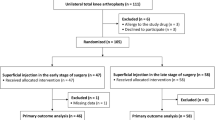Abstract
We aimed to determine the optimal dose of tramadol when administered intraarticularly after arthroscopic knee surgery under general anesthesia in patients with an American Society of Anesthesiologists (ASA) physical status score of I-II. When the surgical procedure was completed, patients were assigned to one of seven groups (n=30 for each) in a double-blinded and randomized manner according to a table of random numbers. Group I received 100 mg tramadol, Group II received 50 mg tramadol, Group III received 20 mg tramadol and Group IV received 0.9% NaCl intraarticularly in 20 ml solutions. Group V received 100 mg tramadol, Group VI received 50 mg tramadol and Group VII received 20 mg tramadol intravenously. Pain was evaluated by using the Visual Analogue Scale (VAS) at 0 min (when the patient was cooperated after extubation), 30 min, 1 h, 4 h, 6 h, 12 h, 18 h and 24 h postoperatively. Patients were administered diclofenac sodium 75 mg intravenously (i.m.) when they experienced pain. The intraarticular tramadol groups had longer duration of analgesia than i.v. tramadol groups who were administered the same doses (I vs V; II vs VI; III vs VII; p <0.001). Group I had the longest duration of analgesia (p<0.001). Group II had a longer time to the first analgesic request than all other groups (p<0.001) except Group I. Consequently, Group I and II needed less analgesics than other groups (p<0.001). Pain scores were 0–3 on the VAS in Groups I, II and V at first assessment, in Groups I and II at 30 min and 1 h, and in Group I at 4 h and 6 h postoperatively (p<0.01). In Group V, vomiting was more a more frequent complication than with other groups (p<0.05). It is concluded that tramadol provides analgesia with a peripheral mechanism when administered intraarticularly. The side effects of intraarticular 100 mg tramadol were no more severe than those for intraarticular 50 mg tramadol. Moreover, intraarticular 100 mg tramadol provided excellent analgesia after arthroscopic surgery.
Similar content being viewed by others
References
Allen GC, St Amand MA, Lui AC, Johnson DH, Lindsay MP (1993) Post-arthroscopy analgesia with intraarticular bupivacaine/morphine. Anesthesiology 79:475–480
Chirwa SS, McLeod A, Day B (1989) Intraarticular bupivacaine (marcaine) after arthroscopic meniscectomy. Arthroscopy 5:33–35
Dahl MR, Dasta JF, Zuelzer W, McSweeney TD (1990) Lidocaine local anesthesia for arthroscopic knee surgery. Anesth Analg 71:670–674
Gerrison KH, Jurna I (1987) Effects of tramadol on motor and sensor responses of the spinal nociceptive system in the rat. Eur J Pharmacol 139:1–10
Gupta A, Bodin L, Holmsröm B, Berggen L (2001) A systemic review of the peripheral analgesic effects of intraarticular morphine. Anesth Analg 93:761–770
Kanbak M, Akpolat N, Öcal T, Doral MN, Ercan M, Erdem K (1997) Intraarticular morphine administration provides pain relief after knee arthroscopy. Eur J Anaesthesiol 14:153–156
Kapral S, Gollmann G, Walt B, Likar R, Sladen RN, Weinstabl C, Lehofer F (1999) Tramadol added to mepivacaine prolongs the duration of axillary plexus blockade. Anesth Analg 88:853–856
Keates H, Cramond T, Smith MT (1999) Intraarticular opioid binding in iflamed tisue in experimental canine arthritis. Anesth Analg 89:409–415
Khoury GF, Chen AC, Garland DE, Stein C (1992) Intraarticular morphine, bupivacaine and morphine/bupivacaine for pain control after knee videoarthroscopy. Anesthesiology 77:263–266
Kürşad H, Karsan O, Yüksek MŞ, Atalay C, Uslu S (1998) The comparison of postoperative analgesic efficacy of intraarticular morphine and intraarticular tramadol. Ağrı Dergisi 6:212–215
Lawrence AJ, Joshi GP, Michalkiewicz A, Blunnie WP, Moriarty DC (1992) Evidence of analgesia mediated by peripheral opioid receptors in inflamed synovial tissue. Eur J Clin Pharmacol 43:351–355
Likar R, Kapral S, Steinkellner H, Stein C, Schafer M (1999) Dose-dependency of intra-articular morphine analgesia. Br J Anaesth 83:241–244
Likar R, Mathischitz K, Burtscher M et al (1995) Randomized, double blind, comparative study of morphine and tramadol administered intra-articularly for postoperative analgesia following arthroscopic surgery. Clin Drug Invest 10:17–21
Raffa RB, Friderichs E, Reimann W, Shank RP, Codd EE, Vaught JL (1992) Opioid and non opioid components independently contribute to the mechanism of action of tramadol, an atypical opioid analgesic. J Pharmacol Exp Ther 260:275–285
Reuben SS, Connelly NR (1996) Post-arthroscopic meniscus repair analgesia with intraarticular ketorolac or morphine. Anesth Analg 82:1036–1039
Stein C, Comisel K, Haimerl, Yassouridis A, Lehrberger K, Herz A, Peter K (1991) Analgesic effects of intraarticular morphine after arthroscopic knee surgery. N Engl J Med 325:1123–1126
Stein C, Millan MJ, Shipenberg TS, Peter K, Herz A (1989) Peripheral opioid receptors mediating antinociception in inflammation. Evidence for involvement of mu, delta and kappa receptors. J Pharmacol Exp Ther 248:1269–1275
Author information
Authors and Affiliations
Corresponding author
Additional information
The preliminary results of this study were partially presented at the Congress of the European Society of Anaesthesiology (ESA), 4–9 April 2001, Gothenburg, Sweden
Rights and permissions
About this article
Cite this article
Alagöl, A., Çalpur, O.U., Kaya, G. et al. The use of intraarticular tramadol for postoperative analgesia after arthroscopic knee surgery: a comparison of different intraarticular and intravenous doses. Knee Surg Sports Traumatol Arthrosc 12, 184–188 (2004). https://doi.org/10.1007/s00167-003-0454-8
Received:
Accepted:
Published:
Issue Date:
DOI: https://doi.org/10.1007/s00167-003-0454-8




